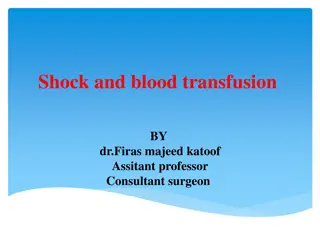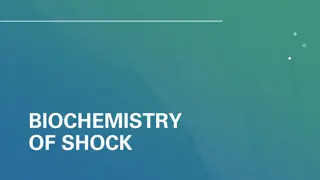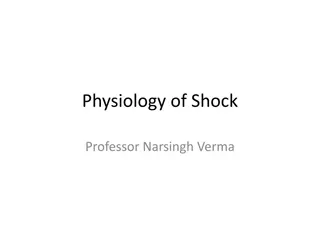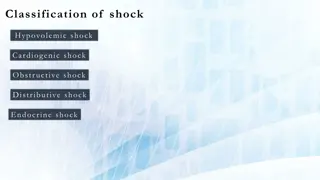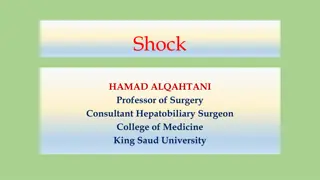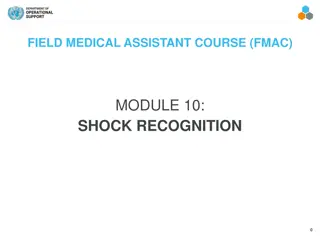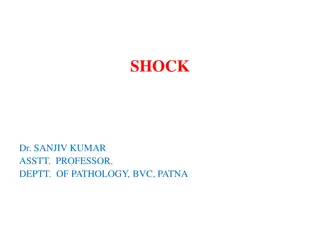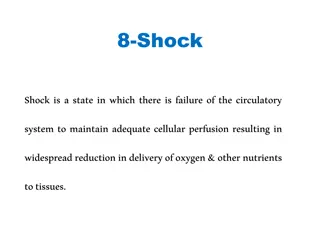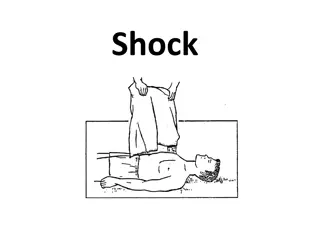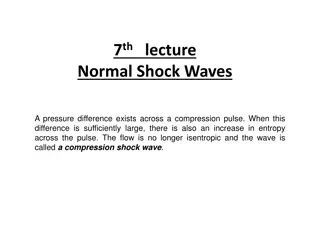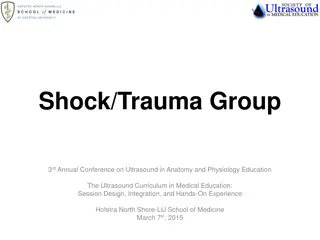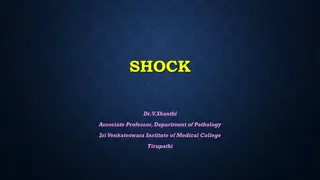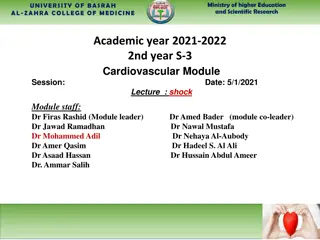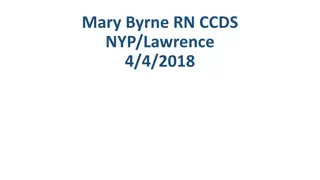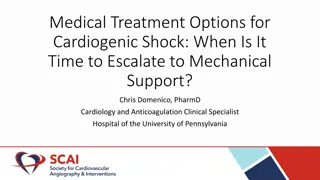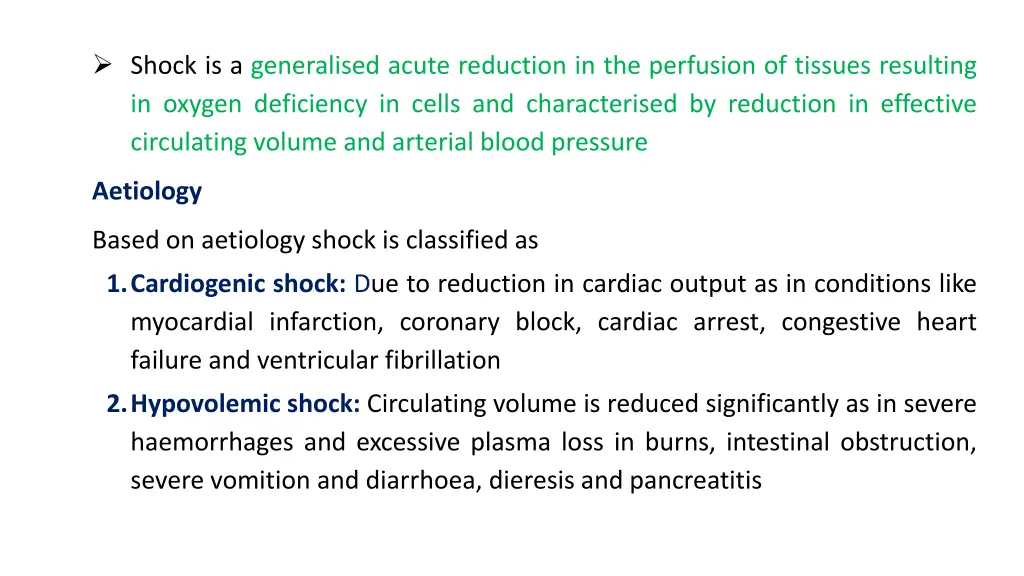
Understanding Types and Causes of Shock
Shock is a serious medical condition characterized by reduced tissue perfusion leading to oxygen deficiency in cells. This article discusses the different types of shock, including cardiogenic, hypovolemic, vasogenic, endotoxic, neurogenic, and anaphylactic shock, along with their causes and pathogenesis. Learn how shock affects the body and the importance of prompt treatment.
Download Presentation

Please find below an Image/Link to download the presentation.
The content on the website is provided AS IS for your information and personal use only. It may not be sold, licensed, or shared on other websites without obtaining consent from the author. If you encounter any issues during the download, it is possible that the publisher has removed the file from their server.
You are allowed to download the files provided on this website for personal or commercial use, subject to the condition that they are used lawfully. All files are the property of their respective owners.
The content on the website is provided AS IS for your information and personal use only. It may not be sold, licensed, or shared on other websites without obtaining consent from the author.
E N D
Presentation Transcript
Shock is a generalised acute reduction in the perfusion of tissues resulting in oxygen deficiency in cells and characterised by reduction in effective circulating volume and arterial blood pressure Aetiology Based on aetiology shock is classified as 1.Cardiogenic shock: Due to reduction in cardiac output as in conditions like myocardial infarction, coronary block, cardiac arrest, congestive heart failure and ventricular fibrillation 2.Hypovolemic shock: Circulating volume is reduced significantly as in severe haemorrhages and excessive plasma loss in burns, intestinal obstruction, severe vomition and diarrhoea, dieresis and pancreatitis
3. Vasogenic shock: vasoplegia It is recorded in severe traumatic injury, burn, prolapse of uterus, intestinal rupture, major surgical operation or severe pain 4. Endotoxic shock: The endotoxins produced by gram negative bacteria, absorption of toxins from intestine and mammary gland may endotoxic shock as seen in acute diffuse peritonitis or coliform mastitis 5. Neurogenic shock: Distributive type of shock resulting in hypovolaemia due to destruction of autonomic nervous system Circulatory failure results from vasodilation and/or result into It occurs due to pain or depression of the central nervous system 6. Anaphylactic shock: It is due to abnormal antigen-antibody reaction that causes release of histamine-like substances and development of shock
Pathogenesis circulating volume due to which cardiac output is reduced and hypotension develops leads to decreased supply of blood to various organs Irrespective of causative agents there is marked reduction in effective It phosphorylation is blocked causes tissue anoxia and anaerobic glycolysis occurs as oxidative Results in excess accumulation of lactic acid, lactic acidaemia and intracellular acidosis systemic circulation in intestinal ischaemia, injury or enteritis toxins Endotoxic or toxic shock develops when endotoxins or other toxins enters in greater amount when not cleared by liver in case of
Toxins passed into systemic circulation as well as into peritoneal cavity and cause peripheral vasodilatation and reduction in circulating volume The toxins or endotoxins also damage the endothelial lining of blood vessels It causes inadequate supply of oxygen to the tissues leads to disturbance in oxidative cellular metabolism and production of arachidonic acid The arachidonic acid is metabolised to produced eicosanoids like leukotriens, prostaglandins and thromboxane A2, which are potetent vasoactive compounds and affect adversely vascular reactivity and permeability All these factors help in development of toxic shock If sepsis persist for some time vascular permeability is altered, and fluid and albumin from circulation are leaked into interstitial space It results in hypovolaemia and there is development of reduced venous return and reduced cardiac output In irreversible shock there is loss of cellular integrity in all tissue and development of disseminated intravascular coagulation
Clinical findings In the initial stage of endotoxic shock capillary refill time (CRT) and blood pressure remain normal, but tachycardia and congestion of mucous membrane occurs During shock the visible mucous membrane become pale grey or muddy and capillary refill time is increased to 3-4 min Animals become dull and depressed, weak and recumbent, reduction in venous blood pressure and veins can not be raised easily The extremities become cold while body temperature remains subnormal Respiration is shallow and rapid while heart rate is increased and pulse is weak, has small amplitude and low pressure Untreated cases go in coma and die
Necropsy findings Dehydration and wide spread petechial and ecchymotic haemorrhages and in endotoxic shock congestion `of capillaries and pulmonary oedema Diagnosis History and clinical signs: History of illness along with clinical signs Measurement of arterial blood pressure: This gives idea about the presence of shock and its severity, a level below 100 mm Hg indicates the presence of shock and level below 60 mm Hg is usually fatal if not reversed immediately (Normal- 120 mm Hg) Blood examination: Reduction in blood PH(<7.35) and elevation of eosinophil count Blood urea and creatinine may be elevated while haematocrit and total protein may or may not be elevated Electrocardiography: It is helpful in diagnosis of shock due to cardiac involvement In myocardial ischaemia there is prolongation of QRS interval and peaked or inverted T wave
Treatment The precipitating cause of shock should be eliminated To prevent anoxia and tissue damage it is very essential to restore the blood volume through fluid therapy Fluid therapy: It should be done quickly since it will help in restoring circulatory function and tissue perfusion As crystalloid solutions (fluid contains electrolytes), isotonoic solutions like Ringer s lactate, 0.9% Sodium Chloride, dextrose saline may be given in large amount (50ml/kg b wt) or colloid solutions (increase osmotic pressure and expand plasma volume) like dextran, gelatin polymers or hexastarch may be given in lower amounts so as to cause sustained increase in plasma volume These fluids may induce coagulopathy or pulmonary oedema, so to overcome this isotonic solution should be given initially then small amount of hypertonic saline solution (7.2% Saline solution @ 3-4 ml/kg b wt)
In endotoxic shock to overcome bacterial agent broad spectrum antibiotic or combination of antibiotics should be used for 5-7 day Glucocorticoids like dexamethasone is used @ 5-10 mg/kg body iv. to overcome toxins and its effects In endotoxic shock, use of cyclo-oxygenase inhibitors like flunixin meglumine @ 2 mg/kg b wt since they inhibit the production of vasoactive prostaglandin and thromboxane A2 Beta- adrenergic stimulators like isoproterenol is useful in restoration of circulatory blood volume
Multiple Choice Q. 1. What is the primary characteristic of shock in animals? A.Increased blood pressure B. Adequate tissue perfusion C. Inadequate oxygen delivery to tissues D. Elevated heart rate only Q.2. Which of the following is not a common type of shock in animals? A. Hypovolemic shock B. Distributive shock C. Cardiogenic shock D. Diabetic shock Q.3. Hypovolemic shock is usually caused by: A. Sepsis B. Blood or fluid loss C. Heart failure D. Allergic reaction What is a common clinical sign of shock in animals? A. Pink, moist mucous membranes B. Strong pulse C. Tachycardia (increased heart rate) D. Increased appetite
Q.5. Which type of shock is commonly associated with severe infection? A.Hypovolemic B. Cardiogenic C. Neurogenic D. Septic (distributive) Q.6. In shock, capillary refill time (CRT) is usually: A.Less than 1 second B. Between 1 2 seconds C. Prolonged, more than 2 seconds D. Not affected Q.7.The initial treatment goal in managing shock in animals is to: A. Administer antibiotics B. Correct the underlying disease C. Restore blood volume and perfusion D. Sedate the animal


